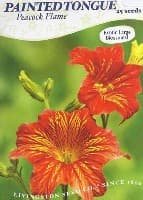How to Grow Painted Tongue

Growing Painted Tongue Flowers in Your Home Garden
Painted Tongue flowers are a hardy annual flower plant, that grows best in cool weather. They will grow best in spring and fall, and slowly in hot summer months. Plants are native to Chile in South America. When growing Painted tongue flowers, make sure you know the variety. Taller varieties should be placed in the back of the flower garden. And, plant dwarf varieties in the front of the garden.
Painted Tongue plants have lance-shaped leaves. with five-lobed, cornet-shaped flowers. Colors include shades of orange, red, pink, violet, and yellow. Cooler weather will prolong blooms.
Did You Know? Painted Tongue is a member of the Solanaceae family. This includes petunias, peppers, and tomatoes.
Flowers Bloom: Spring thru mid-summer, and again in Fall
Plant Height: 1 to 3 feet. Dwarf varieties grow just 18 to 24 inches.
Other Names: Peacock Flame, Velvet Trumpet Flower, Scalloped Tube Tongue
Annual, Salpiglossis Sinuata
Painted Tongue Plant Propagation
Painted Tongue seeds can be difficult to germinate. We recommend an indoor start.
Sow Painted Tongue seeds indoors four to six weeks before the last frost. We highly recommend a heated germination mat. It increases the speed of germination, and for a higher germination rate.
Plants can also be started directly into your flower bed. Sow seeds after the last frost when the soil begins to warm.
Garden Tip: Seeds need consistent moisture to germinate.
Days to Germination: 14 – 21, normally. It can take up to 30 days.
How to Grow Annual Painted Tongue Flower Plants
Grow this plant in cooler climates, It will not grow well in hot, humid southerly areas of the country.
Plants grow best in full sun to light shade.
Painted Tongue will grow in average soils. However, the soil should be well-drained.
Plants do not need a lot of fertilizer. For average soils, apply light applications every 4-6 weeks.
Water plants during dry spells, and especially in hot weather.
Mulch around plants to keep weeds down, and to retain soil moisture.
Pinch back growing tips when the plant is young, This will promote a bushier plant.
Provide support for these stems, as high winds can knock them over.
Deadhead spent flowers to prolong flowering.
Ideal Soil pH: 6.6 – 7.3.
Insects and Plant Disease
Aphids can be occasional problems. Disease problems are uncommon.
If insect or disease problems occur, treat early with organic or chemical insect repellents and fungicide.
Related Articles
Also, people who read this article will like:
Plant Problems – Identify the causes and find the cures.
Please support our site. Shop for:
- rmmatthews100@hotmail.com
- 585-721-6528
- Rochester, NY
©1999-2024 GardenersNet.Com, All Rights Reserved

